Replaces
2009 Mercury Mountaineer Front 8 Piece Steering & Suspension Kit TRQ PSA59129
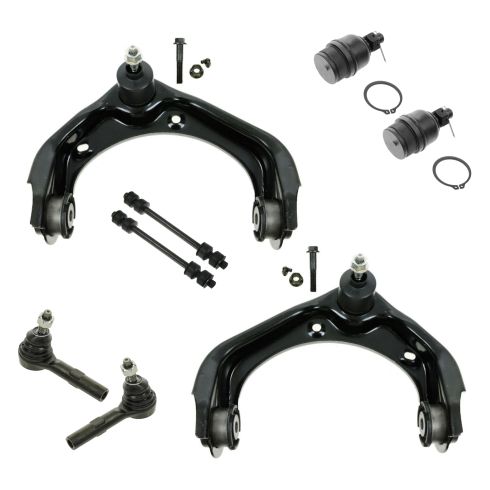


PSA59129
In Stock
This part doesn’t fit a . Select from parts that fit.
Specify your vehicle's year, make and model to guarantee fit.
Orders must be placed by 2pm ET

You may also like
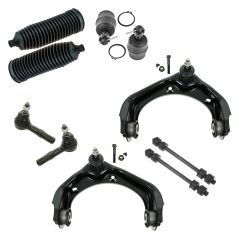
10 Piece Steering & Suspension Kit
$166.95
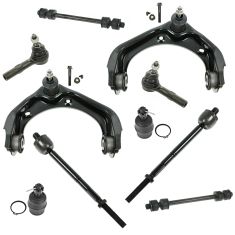
10 Piece Steering & Suspension Kit
$169.95
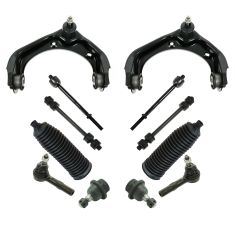
12 Piece Steering & Suspension Kit
$173.95
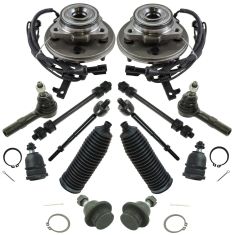
14 Piece Steering, Suspension, & Drivetrain Kit
$206.95
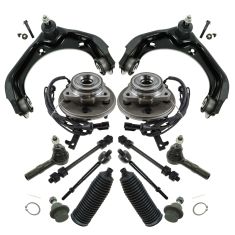
14 Piece Steering, Suspension, & Drivetrain Kit
$271.95
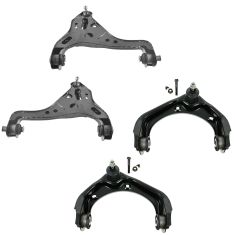
4 Piece Control Arm with Ball Joint Set
$314.95
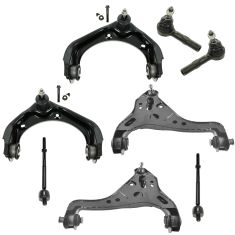
8 Piece Steering & Suspension Kit
$342.95
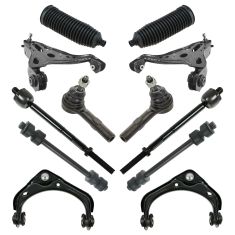
12 Piece Steering & Suspension Kit
$351.95
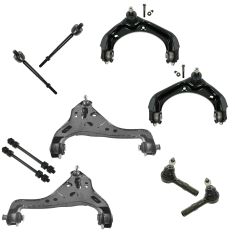
10 Piece Steering & Suspension Kit
$374.95
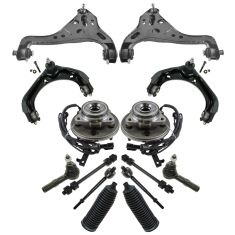
14 Piece Steering, Suspension, & Drivetrain Kit
$466.95
Part Details
-
Kit Includes:
(2) Front Lower Ball Joints
(2) Front Upper Control Arms with Ball Joints
(2) Front Sway Bar Links
(2) Front Outer Tie Rods - Quantity: 8 Piece
Specification
- Front
TRQ suspension kits are manufactured using premium raw materials and coatings for extended service life. Each TRQ suspension component is designed to be a direct, maintenance-free replacement to the stock unit. To extend the life of your steering and suspension components, TRQ recommends replacing components in pairs, sets, or kits. All products are fit and road-tested in our Massachusetts R&D facility to ensure we deliver on our promise of Trusted Reliable Quality.
Product Features
Install Tip: When replacing steering components, have a professional alignment performed afterwards. This ensures proper tracking and even tire wear.
Our steering and suspension components are pre-greased and sealed for long life and do not require the extra maintenance typically required by greaseable versions.
Item Condition:
New
Attention California Customers:
![]() WARNING: This product can expose you to chemicals including Lead and Lead Compounds, which are known to the State of California to cause cancer, and birth defects or other reproductive harm. For more information, go to www.P65Warnings.ca.gov.
WARNING: This product can expose you to chemicals including Lead and Lead Compounds, which are known to the State of California to cause cancer, and birth defects or other reproductive harm. For more information, go to www.P65Warnings.ca.gov.
Lifetime Warranty
This item is backed by our limited lifetime warranty. In the event that this item should fail due to manufacturing defects during intended use, we will replace the part free of charge. This warranty covers the cost of the part only.
FREE Shipping is standard on orders shipped to the lower 48 States (Contiguous United States). Standard shipping charges apply to Hawaii and Alaska.
Shipping is not available to a P.O. Box, APO/FPO/DPO addresses, US Territories, or Canada for this item.
Expedited is available on checkout to the United States, excluding Alaska, Hawaii.
Final shipping costs are available at checkout.







Created on:
Tools used
- Pull off the center cap Loosen the lug nuts Remove the cotter pin and loosen the 35mm hub nut Loosen the seven 13mm 12-point bolts that hold the axle to the front drive Raise and secure the car Remove the wheel
- Spray the torsion bar with spray paint and loosen the torsion bar tension bolt with an 18mm bolt
- Use a pair of pliers to remove the cotter pin Remove the nut at the end of the tie rod Use a tie rod puller to separate the tie rod
- Use a 9/16 wrench to secure the bottom and a 14 mm socket to unbolt the stabilizer link Use a hammer and punch to remove the stabilizer link
- Unbolt the seven bolts, using a pry bar to keep the hub from rotating Remove the hub nut using a 35 mm socket Give the axle a tap with a hammer and pull the axle out
- Use a jack and wood plank or two to lift the control arm and relieve tension from the ball joint Unbolt the the ball joint using a breaker bar and 27mm socket Use a ball joint removal tool to pull the ball joint apart With a ball joint press, remove the ball joint completely See Part Two for reassembly
Brought to you by 1AAuto.com your source for quality replacement parts and the best service on the internet. Hi, I'm Mike Green. I'm one of the owners of 1A Auto. I want to help you save time and money repairing or maintaining your vehicle. I'm going to use my 20-plus years experience restoring and repairing cars and trucks like this to show you the correct way to install parts from 1AAuto.com. The right parts, installed correctly that's going to save you time and money. Thank you and enjoy the video.
This video is part one of a two-part series, replacing the ball joint in this '97 Expedition. In this video, we basically detail removing the old ball joint. This is the same for all the Expeditions, F150s, Explorers, a whole bunch of the Ford trucks and SUVs from this era.
Here's a list of the tools that we use on the Expedition. If you're doing a vehicle different from the Expedition, some of these sizes may differ. You will need heavy-duty tools. You're not going to want to try this with the 20-piece set Uncle Joe gave you for Christmas. This is heavy work. You'll need jack and jack stands, metric sockets 13-27 mm, standard sockets 1/2 inch to 7/8, you'll need a 35 mm socket, a 12 point 13 mm socket, ratchets extensions and a breaker bar or pipe because you will need to get some leverage on some of those bigger bolts and things, pliers, hammer, a heavy punch, ball joint removal tool, ball joint press, large flat blade screwdriver, and a paint marker or a old can of spray paint. The ball joint removal tool I'd recommend if you're going to be doing a lot of your own work. It's a pretty affordable tool to go out and get. Ball joint press might be something that you want to borrow.
Obviously, you're going to start by removing your cap. If you don't have the benefit of air tools, what you'll want to do is start with your wheel on the ground. With your wheel on the ground, there are probably three things you're going to want to do. Loosen your lug nuts. Then there's a 35 mm bolt in the center that holds the axle into the hub you're going to want to take the cotter pin and the cover off of that and loosen that 35 mm bolt. Also, go underneath and there are seven 13 mm 12 point bolts that hold your axle to your front drive. You'll want to just loosen those seven bolts. Much easier to loosen all these bolts with your tire on the ground held in place if you don't have all the tools that I have access to. You're going to want to loosen up your torsion bar. Your torsion bar is actually your spring. This is what supports the vehicle. I'm just going to take a little silver spray paint ... That way, when I back that bolt out, I'll know where it originally was.
Using an 18 mm socket and a ratchet, I'm going to loosen the torsion bar tension nut, or bolt, and you can basically pull it all the way out and then just turn it back in a few turns. You just want to loosen it up and take as much tension off the torsion bar as you can. You can see as I'm done, you can see where there's no paint on the threads, that that is how far you would want to retighten it. Now we're going to undo our tie rod end here. I'm just going to speed it up here. The cotter pin's very rusty, so first so first I break it with the pliers. Then I use a hammer and punch and just kind of keep working and breaking small pieces off until I can drive it through and out of the tie rod end. Now I'm pounding a 21 mm socket onto that nut because it was quite rusty. I just want to make sure I get a good socket that gets a good grip on it.
I've got a bar on here. Put a piece of pipe on it for some more leverage. Hopefully it comes apart. Just fast forward here as I switch over to a ratchet and remove the nut the rest of the way. Here I'm going to put a tie rod, it's a tie rod and ball joint tool, but obviously I'm using it to do a tie rod right now. By using this tool, I can assure that I can just reassemble my tie rod. I won't damage the tie rod by removing it this way. Next, I'm going to remove the stabilizer link, so I'm going to spray the top of it with some penetrating oil and let it sit for awhile. These stabilizer links are sometimes difficult to get apart. You can use hand tools. They will come apart. I just chose to use a impact wrench just to make it easier. I have a 9/16 socket on the bottom and a 14 mm socket on the top.
Use a hammer and pound down on that bolt. Then use a punch, see if you can it to go down through the sleeve. I end up actually having to use vice-grips and a wrench. Obviously, you also want to remove the other side so you can move your stabilizer bar around easily. What I'm going to do here, put set of vice-grips onto this shaft, tighter here. Now we're going to remove the half shaft of the CV axle. As I said in the beginning of the video, these are the bolts that if you don't have all the tools that I have, it might be easier to just loosen them while the vehicle's on the ground. You can see I use a big, large crowbar to hold the hub in place while I'm loosening those bolts.
You can see I spin it, loosen one of the bolts, spin it some more, loosen another bolt. If you were actually doing this with your vehicle on the ground, you'd have to probably loosen one or two of the bolts, then roll your car a little bit, put it in park, put the emergency brake on, loosen a couple more, and keep repeating that process.
Once it's unbolted, pull it down and off. I use a pair of pliers and either break off the ends or just straighten out the cotter pin and pull it out. Okay, 35 mm ... As I said in the beginning, if you don't have impact tools and this is easier with the tire on and on the ground, your other option would be to have a helper hold the brakes while you remove it.
What I do is give it one tap and just watch it, see if it moves. Actually, it moves pretty freely. You can pull your stabilizer bar up and out of the way. Pull your axle down towards the front. Then push it, lift it up, push it out. I've got the vehicle support under the frame. Then I've got my jack right under the control arm. You can see there is the bolt for the ball joint, and then there's the jack. I have a piece of the wood on there so I can easily access that ball joint bolt, as well as get a puller on there. Now I can jack it up. You can see, without that torsion bar tightened, the suspension travels here very easily.
Now I'm going to use pliers to break off and remove the cotter pin from the lower bolt. It ends up being kind of a rusty mess, so I actually use a hammer and punch and pretty much just break it away as much as possible so I can get that bolt off. Now a 27 mm socket put it on there, use a little hammer, make sure it goes all the way on. Got a breaker bar on there, actually you're going to take piece of pipe, put it on, give me some extra leverage. It's coming loose. Just one note here: It will help if you take your tie rod and put it back into the steering knuckle and just put the bolt on. That tie rod will hold things in place while you loosen that ball joint nut.
Just speed it up as I change over to my ratchet and take that bolt most of the way off. While my bolt's still on there, take my ball joint removal tool- This just, doing it this way, allows you to break it free without things falling down. Finish removing this bolt. Get your control arm on up. Pull the steering knuckle down and off.
There's a snap ring that holds the ball joint in place. You can use snap ring pliers. Mine was pretty rusty so I used a screwdriver and a hammer to just kind of pry it off and pop it off.
Now you're going to take a ball joint pulling tool, put the collar up on there. With this particular press use a 7/8 socket, put one on top there, and just tighten down the press. Traded my ratchet handle for my breaker bar. I'm going to speed it up here. What I did there was I created a whole lot of pressure by tightening it down. Then I used a hammer, gave it a good whack that kind of broke it free, and then the press just works it the rest of the way out. There's my old ball joint out.
Good a place as any to end it. Check out part two for the reassembly.
We hope this helps you out. Brought to you by www.1AAuto.com, your source for quality replacement parts and the best service on the Internet. Please feel free to call us toll-free, 888-844-3393. We're the company that's here for you on the Internet and in person.
Tools used
- Pry off the center cap with a flat blade screwdriver Loosen the lug nuts with the vehicle on the ground Raise the vehicle with a floor jack Secure the vehicle on jack stands Remove the lug nuts Pull off the wheel
- Break off the cotter pin from the lower ball joint nut Remove the 24mm nut from the lower ball joint Thread the 24mm nut back on a couple of threads Remove the 30mm axle nut Twist the 30mm nut on until it's flush with the end of the axle Tap the 30mm nut with a hammer to hold it in place Remove the 18mm nut from the upper ball joint Thread the 18mm nut back on a couple of threads
- Remove the 15mm nut from the top of the sway bar link Raise the opposite side of the vehicle with the jack Apply rust penetrant to the sway bar link Hold the sway bar link with vise grip pliers Loosen the sway bar link with a 15mm socket and ratchet Tap the sway bar link out with a hammer
- Remove the cotter pin from the tie rod nut using pliers Remove the 19mm nut from the tie rod Thread the 19mm nut on a couple of threads Strike the steering knuckle with a hammer until it comes free Remove the 19mm nut from the tie rod Pull out the tie rod
- Strike the steering knuckle with a hammer to loosen the lower ball joint from the knuckle Support the lower control arm with a jack Tap the axle loose from the steering knuckle with a hammer Twist off the axle nut Remove the upper ball joint nut Pull the upper control arm out of the knuckle Remove the lower ball joint nut Pull the lower ball joint and the axle out of the steering knuckle Put the steering knuckle onto the upper ball joint Thread on the upper ball joint nut
- Remove the snap ring from the top of the ball joint Put the ball joint press onto the ball joint Tighten the ball joint press to break the ball joint free Pull out the ball joint
- Carefully pry the boot off the ball joint with a flat blade screwdriver Put the ball joint into the ball joint press Push the ball joint into place Tighten the ball joint press Push the boot onto the ball joint Put the snap ring onto the ball joint
- Remove the upper ball joint nut Push the lower ball joint and the axle into the wheel knuckle Thread on the lower ball joint nut Push the upper ball joint into the wheel knuckle Thread on the upper ball joint nut Push the tie rod into the steering knuckle Thread on the tie rod nut Tighten the tie rod nut to 50 foot-pounds of torque Push the cotter pin through the tie rod nut Bend the cotter pin into place Tighten the upper ball joint nut to 50-55 foot-pounds Thread on the axle nut Tighten the axle nut preliminarily Raise the steering knuckle with a jack Tighten the lower ball joint nut to 70-75 foot-pounds Turn the nut to line up the cotter pin hole Push the cotter pin through the lower ball joint nut Bend the cotter pin into place
- Put the grease fitting onto the ball joint Tighten the grease fitting with a 7mm wrench Add grease to the grease fitting with a grease gun
- Put a washer on the sway bar link Put a bushing on the sway bar link Slide the sway bar link into place Put a bushing on the sway bar link Put a washer on the sway bar link Put a metal tube on the sway bar link Put a washer on the sway bar link Put a bushing on the sway bar link Lift the opposite wheel with a jack to raise the sway bar Put the sway bar onto the sway bar link Put a bushing on the sway bar link Put a washer on the sway bar link Lower the opposite wheel Fasten the nut onto the sway bar link
- Slide the wheel into place Start the lug nuts by hand Tighten the lug nuts preliminarily Lower the vehicle to the ground Tighten the lug nuts to 100 foot-pounds in a crossing or star pattern Tighten the axle nut to 184 foot-pounds Reattach the center cap
Brought to you by 1AAuto.com, your source for quality replacement parts and the best service on the Internet.
Hi, I'm Mike from 1A Auto. I hope this how-to video helps you out, and next time you need parts for your vehicle, think of 1AAuto.com. Thanks.
In this video, we're going to show you how to replace the lower ball joint on this 2003 Mercury Mountaineer. We show you on the driver side, but the passenger side is the same procedure. It's the same part and similar process on these Mountaineers from '97 to 2010. The items you'll need for this are a new lower ball joint from 1AAuto.com; 15, 18, 19, 21, 24 and 30mm socket and ratchet; a piece of pipe for some leverage; pliers; snap-ring pliers; a flat-blade screwdriver; hammer; ball joint press; torque wrench; jack and jack stands, and locking pliers, depending on the condition of your sway bar link.
Start off by removing your hub cab and then remove these 19mm lug nuts. If you don't have air-powered tools, you want to loosen them up while the vehicle's on the ground, then jack up the vehicle and support it, and then loosen the lug nuts the rest of the way. Once you've removed those, you'll be able to pull it free.
Now, you want to break off the ends on the Cotter pin right here underneath your wheel knuckle and then you can either hammer it out with a punch or, if the Cotter pin is only sticking out on one side of the castle nut, you can actually just use your 24mm socket and ratchet to break it free. Then, just remove that nut and then put it back on just a few threads.
Remove the nut on the end of the axle and, obviously, if you have air-powered tools it's not a problem. You can have somebody hold the brakes and use a socket and breaker bar if you need to. You want to twist this nut back on until it's flush with the axle and just hammer it until you can see it move. Then come up here and just remove this 18mm nut. With that nut twisted on, again, just a few threads, hammer the wheel knuckle until it drops down. Then, using a 15mm socket and ratchet, you want to remove the nut at the top of your sway bar link. You can hold the bottom with a wrench if it's turning. You can see ours is turning and, in an ideal world, this would just loosen up and you could pull it down, but the top of ours just breaks off.
To help get it out, you want to jack up the other side of the vehicle, and this will lift the sway bar on this side, allowing you to get to the top of sway bar link easier. We'll just spray it with some penetrating oil. Then, using locking pliers, you want to hold onto it while twisting the nut on the bottom of the sway bar link. You'll notice that the plastic will start breaking away and that's fine. You just want to keep repeating the process until all the plastic is gone and you have better access to it. We'll fast-forward as Mike does this. When it gets to this point, you'll be able to remove it and slide it down and out. If it is jammed up, just use a hammer.
Now disconnect your tie rod end, so remove the Cotter pin from the tie rod and I break off the bent over section. I just break it off and then I'm able to pull out the rest of the pin. Then, a 19mm socket, ratchet and a breaker bar loosen it up. You want to take the nut all the way off and then just thread it back on a few threads. Then hit the steering knuckle with a hammer until it pops free. Remove the nut and take the tie rod off and set it aside. If the nut is still on the lower ball joint, hit with a hammer to break it free.
Now support your lower control arm. You can see I have jack stands underneath the frame in the front for both sides. Jack that up with a jack. Here again, make sure the axle is free. I'm not hitting that hard. You don't want to hit your axle too hard because you could damage the CV joints. I'm really just tapping it. Jack it up a little further and now just lift up on the steering knuckle and remove the nut from the lower ball joint. Now remove the nut at the top of the wheel knuckle and pull the upper control arm out of the knuckle.
Take the axle out. Then, you want to take the wheel knuckle and pull it off the stud on the lower ball joints. Just remove that nut the rest of the way. Put it back on there and then just pull the wheel knuckle down and off that stud while pulling your axle out at the same time. It can be a little difficult, but it will eventually go. It's a good idea to just keep it secured to the top of the upper control arm, so just put that nut back on halfway for now.
Using snap-ring pliers, remove the snap ring along the top of the ball joint. Once you get it about halfway, you can just use a flat blade screwdriver and pry it up the rest of the way. With the ball joint press, we've got a cup around the lower part of the ball joint and that there, with a hole through there, so just press the ball joint right down through. I'm just tightening the press and then I hit it with a hammer at the same time, and that just kind of helps to break the ball joint free.
On the left is the old ball joint; on the right is the new one from 1A Auto. They do look similar, but there's some slight differences. However, ours will fit exactly the same. Remove the nut from your new ball joint and then you want to just carefully pry this boot off. Then set up your ball joint press and push the ball joint back into place. Again here, I'm going to tighten it up and just use the hammer to shock it a little bit to help it work its way in.
Once it's all the way back in, just replace that boot and make sure it's on all the way. Take your snap ring and put the snap ring along the top and make sure it's all the way down. Now take your wheel knuckle and you can remove the nut at the top holding it to the upper control arm. Then you want to feed your axle through while putting it back on that stud for your ball joint. This can take some maneuvering, but it will go, and then when you get enough space in the lower ball joint, you want to just replace that nut so it will hold it in place there.
Now push your upper control arm back into the wheel knuckle and replace that nut. Take your outer tie rod and push it back down and into the wheel knuckle and replace that nut. Then you want to torque that to 50 foot-pounds.
Push your new Cotter pin through, or your old one if you managed to save it, then just bend the tabs in opposite directions. Torque the upper ball joint nut to 50 to 55 foot-pounds.
Now replace the axle nut. Tighten it preliminarily. Put a jack underneath your steering knuckle and this basically raises the knuckle onto the ball joint to hold the ball joint in place. You want to tighten that nut up to 70 to 75 foot-pounds, and then further if you need to, to get the Cotter pin through.
Now, you can lower the wheel knuckle and then twist in your grease fitting at the top of the ball joint. We actually end up putting in a 90-degree grease fitting so it's a little easier to grease, and just tighten it up with our 7mm wrench. Then, just top the ball joint off with some grease.
Now you want to replace your sway bar link and you could see that ours was badly destroyed, so we're going to use a new one. You just slide it up through and the order is washer, then bushing, then the lower control arm, then bushing, then washer, then that metal tube, and then another washer and another bushing. Then it should be the sway bar, but you can see that the sway bar is just a little bit too low, so if you jack up the other wheel, you can see the sway bar go up and now you can fit in that bushing. Push the sway bar link up through the sway bar and then do another bushing, then a washer and then the nut. Then just lower the other side and it will compress the sway bar link and then just tighten that up with your 15mm wrench and 15mm socket and ratchet. For your final tightening of the stabilizer link, you can see I've got the vehicle on the ground, and the jack's underneath holding the suspension up in its usual ride height, and then I want to tighten it up so that the bushings basically come out to the same spot as the washers, basically compress the bushings down.
We'll fast-forward as Mike replaces the wheel and then replaces those lug nuts and just tightens them up preliminarily. Then lower the vehicle and torque each of the lug nuts to 100 foot-pounds in a crossing pattern. Then torque this 30mm nut to 184 foot-pounds, and then just replace your hub cap.
We hope this video helps you out. Brought to you by www.1AAuto.com, your source for quality replacement parts and the best service on the Internet. Please feel free to call us toll-free, 888-844-3393. We're the company that's here for you on the Internet and in person.
Tools used
- Set up the ball joint in the ball joint press. Get the top of the ball joint flush with the top of the control arm. Readjust the press, taking the rubber boot off and get the control arm the rest of the way in. Replace the rubber boot. Lock it into place with a snap ring. If you have snap ring pliers, this is much easier but you can do it without them.
- Position the ball joint pointing outward and work the steering knuckle onto it. Lower the jack stand from the control arm. Thread the nut onto the ball joint. Put the grease fitting on the ball joint.
- Get the axle into the hub and transmission. Torque the bolts to 60 foot pounds, using a star pattern to secure the axle evenly.
- Torque the ball joint nut to 98 foot pounds and secure with a cotter pin. Fill the lower ball joint grease fitting with grease using a grease gun. Torque the tie rod nut to 60 ft lbs and secure with a cotter pin.
- Thread the washers and bushings onto the link. Jack the control arm up and tighten the stabilizer link nuts to 15-16 ft lbs. Thread the hub nut on. Lower the jack from the suspension. Retighten the torsion bar to the mark you made earlier.
- Thread the lug nuts on. Lower the vehicle. Torque the lug nuts in a star pattern to 100 ft lbs. Torque the hub nut to 220 ft lbs using your 35 mm socket. Put the retainer and cotter pin and wheel cap on. Have your alignment checked and adjusted.
Brought to you by 1AAuto.com. Your source for quality replacement parts and the best service on the Internet. Thanks for tuning in, this is Part Two of a two part series. We're going to go through reinstalling your lower ball joint on this '97 Expedition. This procedure is similar for a whole bunch of different Ford trucks and SUVs. Here's a list of tools that we used on this Expedition. If you have a different vehicle some of the sizes may differ and one thing that is not on here, you will want a grease gun to grease up the ball joint after you install it.
We've got our control arm here. We're just going to put it right on there like that. Our ball joint, our collar and then that's going to go up and in. We put our press on there. I'm going to speed it up here so we use the press to push the ball joint up and in and you do this in two steps. This first step is just going to get the top of the ball joint flush with the top of the control arm. We're going to take this boot off. Now with this ramp here on top of it. I'll fast forward here again as we use that press to push the ball joint the rest of the way up into the control arm until it's nice and tight, the bottom is nice and tight against the bottom of the control arm and then put your protective boot back on. Now you want to lock it in place with a snap ring. You can get this on without snap ring pliers, but they certainly are a help. Just get this set up.
What I'm going to do is I'm just going to thread the nut on a little bit and then use a hammer to kind of knock the ball joint outward, that helps make it easier to get the other and just keep that protective boot up on there. That's just going to allow your knuckle down on there, your knuckle up, take your jack out of the way. Lift it up on the knuckle and bolt. Okay, I'm going to speed through putting the half shaft back in. One thing I did forget to do, I do a little bit later, is now is the best time to put the grease fitting on top of the ball joint, before you put that axel in there, but put the axel in place to get it into the hub and then get it lined up on the axel and start a couple of those 13 mm bolts. Once you get all the bolts in you want to torque them to 60 foot pounds and what I do is I use a black marker.
I mark the head of them after I torque them. Then you want to kind of go to the opposite side, torque the next bolt, mark it and just keep going until they're all torqued. I'm just putting the tie rod back on. Just put the nut on there and keep it in place. Now we want to tighten the ball joint nut to 98 foot pounds and that's for this '97 Expedition. It could be different for your vehicle. Okay, I put our cotter pin through, bend it down and around. I'm going to fast forward through putting the grease fitting on top. Like I said earlier a little bit easier to do this step before you put the axel in. Then continue to fast forward as a put a grease gun onto that fitting and fill the lower ball joint with grease. Okay, I'm going to tighten my tie rod nut to 60 foot pounds. Next the cotter pin through, bend it down. Here I'm going to install this sway bar link. I've already put a new link on the other side, then just started the nut on it. Bushing, the bushings always go towards the metal.
Okay, so I've got a bushing on the bottom going up to the mount control arm and a bushing above that. Then my shaft goes on there and then the washer, then the bushing pushing down and in. Make sure the bushing is centered in the stabilizer bar unit. Now bushing and washer, then my nut. Now you'll want to use your jack to put some pressure on the suspension and then tighten up the stabilizer to 15 to 17 foot pounds. Then we'll put on our center hub nut. We're just going to tighten that preliminarily. We're not going to torque it until the wheel's back on. Now you can let your suspension back down and you want to re-tighten your torsion bar and since we marked it we can tighten it right back up to where it was before. You can put your tire back on and start each lug nut one by one. Make sure you don't cross thread them. Tighten them down preliminarily. Torque the lug nuts to a hundred foot pounds using a star pattern. Okay, now using a 35 mm socket torque your lug nut to 220 foot pounds. Put the retainer back on and then the cotter pin, then your wheel cap. We recommend you have your alignment checked and adjusted if necessary.
We hope this helps you out. Brought to you by www.1AAuto.com, your source for quality replacement parts and the best service on the Internet. Please feel free to call us toll free 888-844-3393. We're the company that's with you on the Internet and in person.
Tools used
- Loosen the five 19mm lug nuts Raise and support the vehicle Remove the lug nuts Slide off the wheel
- Apply rust penetrant to the tie rod end Loosen the 21mm jam nut on the outer tie rod Remove the 19mm nut from the tie rod ball joint Tap the wheel knuckle with a hammer to loosen the tie rod ball joint stud Remove the tie rod from the wheel knuckle twist the outer tie rod off Count the number of turns it takes to remove the tie rod Hold the inner tie rod with locking pliers Mark one side of the jam nut Twist off the jam nut Count how many turns it takes to remove the jam nut
- Apply anti-seize grease to the outer tie rod and the jam nut Thread on the jam nut Apply anti-seize grease to the inner tie rod Thread the outer tie rod on the number of turns you counted in Step 2 Turn the jam rod to the edge of the tie rod Push the tie rod stud into the wheel knuckle Thread the 22mm nut onto the stud Torque the 22mm nut to 52 foot-pounds
- Slide the wheel into place Start the five 19mm lug nuts Lower the vehicle to the ground Torque the lug nuts to 100 foot-pounds in a crossing pattern
Hi, I'm Mike from 1A Auto. We've been selling auto parts for over 30 years. We're dedicated to delivering quality auto parts, expert customer service, fast and free shipping, all backed by our 100% satisfaction guarantee. Visit us at 1AAuto.com, your trusted source for quality auto parts.
In this video, we're going to be working with our 2006 Ford Explorer. We're going to show you how to remove and replace your vehicle's outer tie rod. We're doing this on the passenger side, but the procedure is the same on the driver side. If you like this video, please click Subscribe. We have a ton more information on this and many other vehicles. If you need this part for your truck, you can follow the link down in the description over to 1AAuto.com. Here are the items you'll need for this repair. Here are the items you'll need for this repair.
Using a 19mm socket and a breaker bar, loosen the lug nuts on your tire. Raise and support your vehicle. We're doing this on a lift to make it easier to show you what's going on, but this job can be done at home on a jack and jack stands. Finish removing your lug nuts. You should be able to do this by hand at this point but you can use a ratchet if you need to. You can then remove your wheel and tire.
It may be a good idea to apply some penetrating oil to whatever parts you're going to be working with. Remove the 21mm jam nut with a 21mm wrench. You really only need to crack that loose.
Remove the 19mm nut from the bottom of the tie rod end at the knuckle. We'll do this with the 19mm socket and ratchet. In order to save our tie rod end and not damage it in the removal process, we're going to use a hammer and hit the side of the knuckle right here to oblong the hole for a second and pop the actual tie rod end out. Be sure to wear proper safety equipment when doing this. Remove the tie rod end. Count the number of revolutions it takes to remove it, so we can install our new one the same way. That looks like 20 for us.
Using a pair of locking jaw pliers, clamp on to the inner tie rod and just brace it against the lower control arm. Mark one side of the nut, so you can count the number of rotations to remove that as well: 28-1/2.
Here we have our old part that we removed from our vehicle and our new part from 1AAuto.com. As you can see there are some minor differences in the size of the piece, but the threads on the inside are the same and we have the same stud and tapered end on the opposite side. If your old outer tie rod has play on the end, this ball socket can get a little bit of slop in it and create some steering and alignment issues. This new part from 1A Auto will go in direct fit just like your original equipment and fix you up right.
I'm just going to put some anti-seize lubricant on the inside of this to make sure that it's always easy to adjust, and we'll do the same thing to the jam nut. Now, our new outer tie rod is just a little bit shorter on the actual female thread piece than our original one was, so I'm just going to spin the jam nut on, and then we'll apply some more anti-seize to the threads. Now, although the actual length on the female threads here is smaller, we're going to go ahead and install it 20 turns just like we did with the part that came off: 1, 2, 3, and your numbers may be different than this. You do just want to go the same amount of rotations. All right. Put back the jam nut until it just touches the end of our outer tie rod.
Then, we reinstall it into the knuckle. Install the new nut included with your new outer tie rod. We'll tighten that down with a 22mm socket and ratchet. Torque the nut to 52 foot-pounds.
Now, when we were knocking the outer tie rod end out of the knuckle, kind of folded the backing plate here. While it's not quite touching our rotor, it's a pretty common issue. You can just take a little pair of pliers and just tweak it until it's just about the same shape as it was. You can see there's some wrinkles and stuff that have happened over the years on it anyway, but just taking that extra second to pull it away is going to keep you from getting annoying noises that can cause you frustration after you've already made your repair.
Reinstall the wheel and tire onto your hub. It's easiest to put a lug nut inside of the 19mm socket to start it onto the studs. Get all five of these down as tight as you can by hand, and then we'll torque the wheel once there's some weight on it. Lower the vehicle back down and put partial weight onto the wheel and tire. This means that you may have your jack or lift under the vehicle. Get the tire to touch and let the vehicle come down some without allowing it completely off of the lift or jack. Torque your lug nuts to 100 foot-pounds in a cross pattern.
Thanks for watching. Visit us at 1AAuto.com for quality auto parts, fast and free shipping, and the best customer service in the industry.
Tools used
- Loosen the five 19mm lug nuts Raise and support the vehicle Remove the lug nuts Slide off the wheel
- Apply rust penetrant to the sway bar link Attach a 17mm wrench to the top sway bar link nut Brace the wrench against the vehicle frame Turn the 16mm bolt at the bottom of the sway bar link to loosen the nut Remove the 17mm nut Tap the top of the bolt with a hammer Remove the sway bar link bolt Remove the sway bar link bushings, washers, and sleeve
- Slide a washer onto the sway bar link bolt Slide a bushing onto the sway bar link bolt Slide the sway bar link bolt through the control arm Slide a bushing onto the sway bar link bolt Slide a washer onto the sway bar link bolt Slide the sleeve onto the sway bar link bolt Slide a washer onto the sway bar link bolt Slide a bushing onto the sway bar link bolt Insert the sway bar link bolt into the sway bar Slide a bushing onto the sway bar link bolt Raise the suspension with a jack Slide a washer onto the sway bar link bolt Thread the nut onto the sway bar link Attach a 17mm wrench to the top sway bar link nut Counterhold the sway bar link nut with the wrench Tighten the sway bar link bolt with a 16mm socket and ratchet Lower the suspension by lowering the jack
- Slide the wheel into place Start the five 19mm lug nuts Lower the vehicle to the ground Torque the lug nuts to 100 foot-pounds in a crossing pattern
Hi, I'm Mike from 1A Auto. We've been selling auto parts for over 30 years. We're dedicated to delivering quality auto parts, expert customer service, fast and free shipping, all backed by our 100% satisfaction guarantee. Visit us at 1AAuto.com, your trusted source for quality auto parts.
In this video, we're going to be working with our 2006 Ford Explorer. We're going to show you how to remove and replace your vehicle's sway bar link in the front. If you like this video, please click subscribe. We have a ton more information on this and many other vehicles. If you need these parts for your car, you can follow the link down into the description over to 1AAuto.com. Here are the items you'll need for this repair.
Using a 19mm socket and a breaker bar, loosen the lug nuts on your tire. Raise and support your vehicle. We're doing this on a lift to make it easier to show you what's going on, but this job can be done at home on a jack and jack stands. Finish removing your lug nuts. You should be able to do this by hand at this point but you can use a ratchet if you need to. You can then remove your wheel and tire.
It may be a good idea to apply some penetrating oil to whatever parts you're going to be working with. Put a 17mm wrench on the nut on the top side of your sway bar link and brace it against the frame of the vehicle. You can then use a 16mm socket and ratchet on the bottom to loosen it. The sway bar link on these vehicles is essentially a series of bushing and washers with a sleeve all held together by one long bolt, as opposed to being a one-piece unit like some other vehicles.
You can see ours is pretty rough here, because there's usually not this much slack. That's actually what your bushing is supposed to look like on all four pieces, one on each side. You can see the old ones are worn down or cut there. It looks like they've actually fallen off over time. Once the nut's out, you can try to remove the bolt from the center of the sway bar link. This can be pretty difficult, so if it doesn't come out by hand, don't be afraid to get on there and give it a good hit with a hammer. The sway bar link will disassemble just like that when you pull it out, so just make sure you have all the old bushing material and all the old washers off of it.
Now you sort of need to build the sway bar link into the truck, so we'll start with a washer and then a bushing. We'll go up through the control arm, install a bushing with the tapered end down, followed by another washer, the sleeve, a washer with the cup end facing up, and a bushing with the tapered end facing up. We'll go through the sway bar, install another bushing. You may need to use a screw jack or floor jack to jack up the control arm to get enough slack on that bolt to install the sway bar link. Then install the washer and a nut and tighten your new hardware down. You'll want a 17mm wrench on the nut and a 16mm socket and ratchet on the bolt end. Just tighten that up until it compresses the bushings so you know that everything's nice and tight and there's no slop in there to make any noise when you go over bumps. Once that's down tight, you can lower the weight off of the screw jack or floor jack.
Reinstall the wheel and tire onto your hub. It's easiest to put a lug nut inside of the 19mm socket to start it onto the studs. Get all five of these down as tight as you can by hand, and then we'll torque the wheel once there's some weight on it. Lower the vehicle back down and put partial weight onto the wheel and tire. This means that you may have your jack or lift under the vehicle. Get the tire to touch and let the vehicle come down some without allowing it completely off of the lift or jack. Torque your lug nuts to 100 foot-pounds in a cross pattern.
Thanks for watching. Visit us at 1AAuto.com for quality auto parts, fast and free shipping, and the best customer service in the industry.
Tools used
- Pry off the center cap with a flat blade screwdriver Loosen the lug nuts with the vehicle on the ground Raise the vehicle with a floor jack Secure the vehicle on jack stands Remove the lug nuts Pull off the wheel
- Hold the sway bar link stud with a 16mm wrench Remove the 15mm nut from the sway bar link If the sway bar link is broken, fill the tube with rust penetrant Hold the tube with vise grip pliers Loosen the sway bar link stud with a 16mm socket and ratchet Pull off the plastic tube Remove any remaining plastic with a hammer and chisel Loosen the sway bar link stud with a 16mm socket and ratchet Push out the stud with a hammer
- Lift the opposite side of the vehicle with a jack Put a washer onto the sway bar link stud Put on a bushing Put the sway bar link into place, through the control arm Put on a bushing Put on a washer Put on the plastic tube Put on a washer Put on a bushing Put the sway bar link into place, through the sway bar Put on a bushing Put on a washer Thread on the 16mm nut Tighten the nut preliminarily Lower the jack Support the suspension at ride height with a jack Tighten the 16mm nut until the bushings are the same thickness as the washers
- Clip the ABS sensor wiring into place Wipe down the rotor Remove the placeholder lug nut Slide the wheel into place Start the lug nuts by hand Tighten the lug nuts preliminarily Lower the vehicle to the ground Tighten the lug nuts to 100 foot-pounds in a crossing or star pattern Reattach the center cap
Brought to you by 1AAuto.com, your source for quality replacement parts and the best service on the Internet.
Hi, I'm Mike from 1A Auto. I hope this how-to video helps you out, and next time you need parts for your vehicle, think of 1AAuto.com. Thanks.
In this video, we're going to show you how to replace the front sway bar link on this 2003 Mercury Mountaineer, same as any 2002 to 2005 Mountaineer, as well as Explorer. Our front passenger side is broken, so we show you how to get it out and replace it with a new one from 1A Auto. You'll need new sway bar link from 1AAuto.com, 16mm and 19mm socket and ratchet, a piece of pipe for some leverage, jack and jack stands and a torque wrench.
You'll want to remove your center cap. If you don't have the benefit of air tools, then loosen your lug nuts with the vehicle on the ground. Then raise both front wheels and support the car with jack stands and then remove the lug nuts and wheel the rest of the way. Now you can pull the wheel free.
This is the driver side, which is actually still together, so you would, if you're removing one that was still together, put a 15mm socket and ratchet on top and a 16mm wrench on the bottom, remove that top nut and then go from there. On ours, it's broken so I'm just filling, basically, the cavity with penetrating oil. This is pretty typical: it breaks off up top here and you saw where you just filled it up with penetrating oil and now we're just messing around with it. We locked some locking pliers onto it. That penetrating oil really helped the bolt start up and we've basically broken the plastic here. Now this plastic tube will slide off.
We're just going to use a hammer and chisel to remove the rest of the plastic. This, of course, is the worst case scenario, you just want to remove the plastic, you can use some locking pliers and then just remove the nut on the bottom or at least loosen it up as much as you can. Then just hammer this down and out.
Before installing it, just jack up the other side, just slightly. Now replace your sway link and the order it should go in is: washer, bushing, control arm, then bushing, washer, the tube, and another washer, and then the bushing, and then your sway bar, then another bushing, another washer, and then the nut. You just want to tighten that nut preliminarily,and then release the jack.
To tighten up the link, what you want to do is have the car back down on the ground, and now I have a jack supporting just the front suspension so that basically everything is level and the suspension is in its correct ride height. Then tighten up the link by holding the wrench on top and then turning the bottom. Tighten it up so that the bushings are all squeezed to about the diameter of the washers.
Replace your wheel, then replace all the lug nuts and tighten them preliminarily. Then you'd want to lower the vehicle and tighten them the rest of the way, then torque each of these in a crossing pattern to 100 foot-pounds. Now replace your hubcap. Just line it up and hit it back into place.
We hope this video helps you out. Brought to you by www.1AAuto.com, your source for quality replacement parts and the best service on the Internet. Please feel free to call us toll-free, 888-844-3393. We're the company that's here for you on the Internet and in person.
Tools used
- Loosen the lug nuts with the vehicle on the ground Raise the vehicle with a floor jack Secure the vehicle on jack stands Remove the lug nuts Pull off the wheel
- Loosen the 18mm castle nut from the control arm Place a pick fork between the knuckle and the control arm Separate the ball joint from the steering knuckle with a hammer Spray the ends of the bolts on the top of the control arm Remove the 18mm bolts from the control arm Stick an 8mm wrench to the bottom of the castle nut Loosen the nut Lock onto the stud with slip jaw pliers Remove the castle nut Pull the control arm out of the steering knuckle Place a bungee cord around the strut and the knuckle Remove the control arm
- Insert the control arm into place and insert the 18mm bolts to the control arm Remove the bungee cord Insert the stub into the steering knuckle Tighten the back 18mm bolts so that the washer is touching the control arm Raise underneath the strut with a jack to simulate the ride height Tighten the 18mm castle nut Torque the two back bolts to 111 foot-pounds Tighten the 18mm castle nut to 41 foot-pounds
- Slide the wheel into place Start the lug nuts by hand Tighten the lug nuts preliminarily Lower the vehicle to the ground Tighten the lug nuts to 100 foot-pounds in a crossing or star pattern
Hi, I'm Mike from 1AAuto. We've been selling auto parts for over 30 years! We're dedicated to delivering quality auto parts, expert customer service, and fast and free shipping, all backed by our 100% satisfaction guarantee. We've created thousands of videos to help you install our parts with confidence. That saves you time and money, so visit us at 1AAuto.com, your trusted source for quality auto parts.
In this video, we're going to show you how to replace the front upper control arm. This is a 2006 Ford Explorer. It’s basically the same for 2006 to 2010. We show you on the passenger side, but the driver's side is the same procedure.
Please click Subscribe to see all our other videos for Explorer, as well as other Fords and other makes and models. To get the part in this video, click the link down in the description and go to 1AAuto.com for thousands of parts for all your needs.
Use your lug wrench or a 19mm socket with a big ratchet or breaker bar, and loosen your lug nuts while the vehicle is on the ground. We’re using a lift, but a jack and jack stands can be used as well. Remove the lug nuts the rest of the way, and then remove your wheel and tire.
With the vehicle supported on jack stands, or on the lift, you want to just put a floor jack underneath and raise up the suspension just to take a little bit of the load off. You need an 18mm and you need a deeper socket to clear the whole stud. Use a nice big breaker bar for some extra leverage and pull. Mine's coming apart pretty easy. Once it gets easy, just go with a wrench, and you want to make sure that this stud isn't spinning. Usually it's not. Leave the nut in place here and use a ball joint fork and a large hammer to separate the ball joint from the steering knuckle.
We're going to spray the ends of the bolts that are at the top of the control arm with rust penetrant. These two bolts are 18mm. The nuts should have a tab that locks into the control arm, so you don't have to hold the nut side. Nice big breaker bar, 18 mm socket on the front one fits in nicely. You can loosen it up. On this side, we'll use a 3/8 because it's just a little smaller. Let’s get in there. The only problem is, it doesn't give us as much leverage. You can see the nut spinning around right now, but in a moment it's going to get caught on the control arm and it'll come apart. If need be, you can use a piece of pipe, put over your ratchet. Just be careful not to overload the ratchet, and apply pressure gently for more leverage. Remove the bolts, just make sure that the nuts don't fall down too far, like that.
Then the bottom of this is an 8mm. The wrench fits on, so if you need to you can hold it. Remove the nut, and once it gets to a certain point, you may have to lock onto the stud with some slip-jaw pliers. Hold it there to remove it the rest of the way. Take the nut out, and lift this up and out. Have a bungee cord ready, put it around to hold the knuckle in place, and then you can pull your broken control arm out.
On the left, you can see the original part out of our 2006 Ford Explorer. On the right, the new part from 1AAuto.com. It's going to install and function just the same as the original. The only differences are very minor and cosmetic. The beauty of these is that they come with the ball joint, so either if your ball joint is bad or your bushings are worn out, installation of a new control arm from 1A Auto is going to fix your problem.
New control arm from 1A Auto, I'm just going to take the new locking nut off. I have one of our bolts ready. Slide it into place, hold the end and through just for now to hold it in place. Same thing down here. Make sure you get your bolts in first. Then our caged nuts in place. Start the bolts on. With those in place, carefully take off your bungee, or whatever's holding the spindle. Just put that down in for now and start the nut. Now, we're going to tighten up for the bolts. We'll tighten them up enough so that the control arm can still move. Once you get it to a certain point, you can push it in and you can see where your washer use to be, so we'll just move right to there and we'll tighten up preliminarily.
This will give you a preliminary alignment, and we do suggest that you get your vehicle realigned after you complete the repair. Once you've done the rear, do the same thing for the front. Before we put the knuckle together, or torque anything, we're going to raise the suspension up to its ride position. So, there should be no weight on your jack stand, or a little bit of space between your jack stand and your frame, and then that usually holds the stud pretty well here. We'll tighten this up.
Now we'll torque our two bolts to 111 foot-pounds. Do a final check and make sure they're lined up where they were originally if it's for a preliminary alignment. Again, torque them to 111 foot-pounds. Tighten this nut to 41 foot-pounds. After everything's tightened up, let your jack down. Again, we do recommend a front wheel alignment after this repair.
Reinstall your wheel and tire. Start all your lug nuts by hand first; make sure they don't cross-thread. Use your lug wrench, socket and ratchet, or whatever and tighten them up preliminarily. Lower the vehicle onto the ground. Tighten your lug nuts to 100 foot pounds using a star pattern to tighten them.
Thanks for watching. Visit us at 1AAuto.com for quality auto parts, fast and free shipping, and the best customer service in the industry.

PSA59129
In Stock
Product Reviews
877-844-3393
Monday - Friday 8:00am - 9:30pm ET
Saturday - Sunday 8:00am - 4:30pm ET
Specify your vehicle's year, make and model to guarantee fit.
This part doesn’t fit a . Select from parts that fit.












